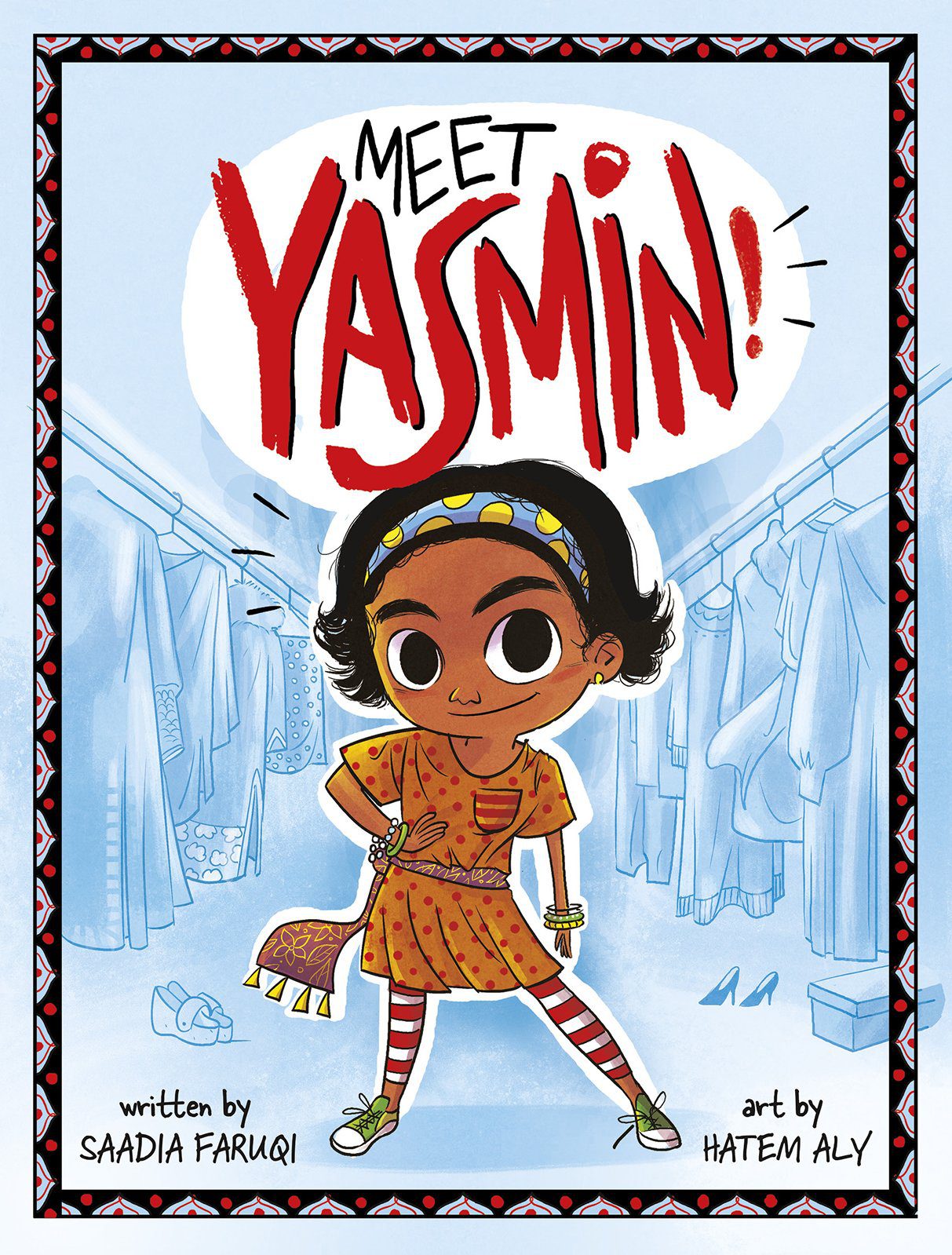
Pakistani-American author Saadia Faruqi’s new children’s book, Meet Yasmin!, follows a second-grade girl’s everyday adventures like practicing to be an explorer at a farmer’s market or creating a painting for a school art show. The book includes bright, colorful illustrations and reading-related activities that will appeal to young readers.
Faruqi’s debut, Brick Walls: Tales of Hope & Courage from Pakistan, a short story collection that illuminates some of the obstacles ordinary Pakistani people face, was released in 2015. She has also been featured in Oprah magazine for her work as an interfaith activist and is the editor-in-chief of Blue Minaret Literary Journal and a co-founder of Have Faith, Will Parent.
I corresponded with Faruqi via email about her new book, her writing process, and the differences in writing for adults versus kids.
***
The Rumpus: Who do you hope to reach with Meet Yasmin!?
Saadia Faruqi: I’m really casting a wide net here. Basically, the series is for kids in grades K–2 but I’ve had teachers reach out to me to tell me that their middle school immigrant students were reading advance copies of it because they’re still learning English. Meet Yasmin! is meant for anyone who wants it. The Muslim child who can’t find anyone resembling her in the pages of the books she reads. The South Asian child who is eager to see more brown kids in stories. The immigrant child who misses his grandparents back home and can’t believe that Yasmin also lives with her Nana and Nani. However, don’t underestimate the power of an adorably cute face and a feisty nature! I’ve heard from parents who are excited about Yasmin and her adventures because they remind them of a certain someone in their lives. So, I always tell people… if you were a child at some point, or if you know any children whatsoever, or you think you’ll have kids in the future, read this series.
Rumpus: You’ve been very upfront about the fact that Yasmin is inspired by your daughter. How does your family feel about having your work and your personal life collide in such a public way?
Faruqi: I didn’t really ask their opinion. The art of writing is almost a dichotomy in my view. We pour our hearts out, our feelings and ideas, onto the page, and it’s a very private thing. Then if we’re lucky we have those private thoughts published and suddenly it’s all very public. Yasmin was born out of my private feelings when I’d see how my daughter reacted to a very white-centric world around her, and how my son responded to bullying and racism in school. But the series I created was neither of those things because Islamophobia or racism or political ideology is very far removed from it. It’s all about a normal little girl doing normal things all children do, but she just happens to be Muslim. It’s not even clear what country Yasmin lives in. So, I suppose I feel that even though the initial idea was inspired by my daughter, the end product is all my own. And Yasmin is perhaps my third child!
Rumpus: Brick Walls was a short story collection. How did your process for writing this book differ from the previous one?
Faruqi: I’m essentially a short story writer at heart. The urgency of the narrative and the brevity of thought makes it so exciting and challenging to me. If you can’t really tell the whole story in five thousand words, are you really a writer? I don’t know. Perhaps that’s why I gravitated to children’s books recently, because let me tell you, it’s not easy. Anyone who thinks writing an early reader series like Meet Yasmin! is easy, hasn’t really written for that age group. You can’t use complex vocabulary, but you still have to create complex, multidimensional characters. You have to create a plot in five hundred words that will entertain readers with the average concentration span of a chimpanzee. And you have to work with an artist to make sure that the words you’re using and the art he’s drawing jives together seamlessly. It’s quite a feat, but the process is actually very similar to short story writing because many of the elements and the sense of urgency is the same.
Rumpus: So, did you collaborate with the illustrator while writing, or did the illustrations come later in the process?
Faruqi: The art goes on almost parallel to the writing process. Once I submit my first draft, and my editor starts the revision process, and the design team begins work on illustrations. I send my initial art notes in the manuscript so that they know what I’m envisioning in each scene, although I have heard from other authors that this isn’t a process that everyone follows. I’m very lucky to have a publisher who values my input and keeps my vision of the story a priority. As I revise, I’m also going back to the art from time to time and giving input. This involves the covers as well as the inside illustrations. Often the editing is completely done, and the art is still being created. It’s really a very fun and interesting process, and probably my favorite aspect of writing an early reader.
Rumpus: What are some themes important to you in writing?
Faruqi: I like to write about identity and culture, so depending on the sort of project I’m working on, I’ll usually weave in those themes to some extent. In many of my short stories there is an element of first generation angst, for instance in my piece in Chicago Quarterly Review. I especially like exploring diaspora issues in my adult writing, and in a couple of my upcoming children’s novels. Another theme that’s really important to me is food—I often include that in my essays as well, such as in this piece and this one.
Rumpus: What environment do you need for writing?
Faruqi: I have a small nook next to our upstairs game room, where I have a whole lot of junk set up in the hope that I’ll be able to write something. The reality is that many times I write at the kitchen table downstairs while I’m keeping an eye on dinner cooking on the stove. But my upstairs nook is a little better in that I have all my computers and my paraphernalia around me, like my tablet with Skype installed in it, for a novel I’m co-authoring with another writer. The problem with my writing process is that I have kids, and kids are really detrimental to your health as a writer. So, a lot of times I have to take my laptop and sit at a Starbucks or the library rather than in my own house.
Rumpus: You also work as an interfaith activist. Has that influenced your writing?
Faruqi: I always tell people my writing is just one aspect of my activism. I see writing as a means to an end, not as the end itself. It’s the way I express my ideas of how the world should be, why we should engage with each other, and what multiculturalism and interfaith really means to me. So, I suppose when I reach those ideals I’ll stop writing. But in the meantime, my books and essays deal with reality and how to improve a few ugly parts of it I see around me: Islamophobia, racism, intolerance, stereotyping and things like that. The trick is to do it in such a way that readers think they’re being entertained!
Rumpus: What do you think about the current conversations around diversity and representing PoC voices in publishing?
Faruqi: I love the idea that publishing is becoming more open to diversity, but I have to caution that sometimes what we see as diversity is really just a pretty packaging. Just the other day I was researching for an article and realized that almost half of Muslim children’s stories are written by non-Muslim writers. The same is true of nonfiction accounts like those of refugees or undocumented people, and any sort of books about Native Americans. Marginalized groups often don’t have access to publishing, but since the industry as a whole is anxious to move forward with diversity and #ownvoices, many authors getting seats at the table don’t belong to those groups. So, while I think it’s important to have more Muslim stories and Native stories and refugee accounts, I also think we need to think how we can amplify #ownvoices.
Rumpus: Who are some writers you admire, both in adult and children’s fiction?
Faruqi: I try to broaden my scope but I’ve found that my current frame of mind (probably the last decade) has been very agitated in terms of what’s going on around us politically and culturally. This means lots of things in my personal life, but as far as my reading habits go, I find myself very attracted to South Asian writers. Some of my favorites at the moment are Balli Kaur Jaswal, who wrote Erotic Stories for Punjabi Widows (adult fiction), and Veera Hiranandani, who wrote The Night Diary (children’s fiction).
Rumpus: What projects are you hoping to work on in the future?
Faruqi: Ah, there’s so much I want to write, but not enough time! Yasmin is a series, so it takes a considerable amount of time, plus I have a couple of other Middle Grade novels and a picture book manuscript I’m working on. I also have an adult short story collection I’m still polishing, so we may see some switching back to adult writing in the future. Or I may just take a nap for the next five years. We’ll see.





